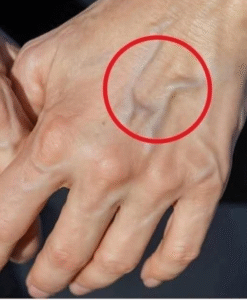Veins can suddenly appear more bulging and visible for several reasons, many of which are temporary and not necessarily dangerous. One of the most common causes is increased blood flow or pressure in the veins. This can happen after exercise, when your muscles demand more oxygen and nutrients, causing blood vessels to dilate and surface veins to become more prominent. Physical activity, especially weightlifting or resistance training, can make veins “pop” as blood flow increases and muscle mass pushes them closer to the skin.
Temperature changes also play a role. In warm environments, blood vessels widen to help your body release heat, which can make veins more noticeable. Conversely, in colder temperatures, veins may shrink and become less visible.
Dehydration can make veins stand out as well, since reduced fluid in the body causes blood volume to become more concentrated and veins to appear more defined. Likewise, if your body fat percentage decreases, there’s less tissue covering the veins, so they naturally become more visible.
Aging can contribute to this too. As skin loses collagen and becomes thinner over time, veins are more easily seen beneath the surface. Hormonal changes, such as those occurring during pregnancy or with certain medications, can also cause veins to enlarge temporarily.
Sometimes, bulging veins can be linked to underlying conditions like varicose veins, which occur when vein valves weaken and blood pools, or to issues with circulation. Prolonged standing or sitting can increase venous pressure, making veins swell. Injury or inflammation near a vein can also cause it to appear more prominent.
If your veins become suddenly visible along with symptoms like pain, swelling, redness, or warmth in the area, it’s important to get medical advice, as this could indicate a blood clot or another vascular issue. In most cases, though, visible veins are a normal reaction to changes in blood flow, body composition, or temperature, and they tend to return to their usual appearance once the triggering factor passes.


